This page provides in-depth information about our IP Accelerator process for clients who want to join Amazon Brand Registry.
Please Scroll to FAQ #1 BELOW If You’re Ready to GET STARTED!
Already familiar with IP Accelerator but want to know more about what it’s like to work with us?
Need some basic information about IP Accelerator & Brand Registry first?
Amazon Brand Registry FAQs for Amazon Seller Clients
If you’re not an Amazon seller, or if you are an Amazon seller but have already joined Brand Registry, please click here to read more about our trademark application services for all other businesses.
+ FAQ #1: What are the benefits of filing a trademark application with your firm?
Currently, sellers cannot enjoy all of the benefits of Brand Registry without first securing a U.S. trademark registration from the U.S. Patent and Trademark Office, a process that can take up to a year. In connection with Amazon’s IP Accelerator program, Amazon has represented that you will have early access to Brand Registry if you file a trademark application with our firm (http://www.amazon-brand-registry.com/eng/contact_us) in which you will have access to the following brand protection benefits:
Proactive brand protections: Amazon will use information provided about the brand to implement protections that attempt to proactively identify and remove potentially bad listings that could harm the brand and Amazon customers.
Powerful search and reporting tools: Participants will have access to the Report a Violation tool that provides powerful text and image-based searching capabilities and simplifies the process of reporting potential infringement with multiple features designed specifically for brands.
Other brand-building features: Sellers will be able to further build and grow their business on Amazon by taking advantage of powerful tools designed for brands such as Enhanced Brand Content (EBC) product detail pages, Brand Stores, Sponsored Brands, and the Brand Dashboard.
For more information, go to https://brandservices.amazon.com/benefits and https://brandservices.amazon.com/faq
+ FAQ #2. What is the process and how quickly can I join Brand Registry?
The steps are these:
Step 1: Review our FAQ. Please review these FAQs covering important topics such as the application process, our firm’s fees for services, and some of Amazon’s quirky policies.
Step 2: Complete the Questionnaire. After you have reviewed the FAQ, please follow the link in the same email attaching these FAQ to complete a short questionnaire aimed at gathering all the background information we need to properly advise you on fees and next steps. Submitting the questionnaire does not obligate you to work with our firm. But we require the basic background information from the questionnaire before you can get input from an attorney.
Step 3: Work with your Assigned Attorney. Once you have completed the questionnaire, an attorney will review your responses and contact you within three business days with next steps. You will work directly with your attorney on strategy and any additional information needed to file your application. The advice provided by your attorney will be based on your response to the questionnaire. As such, it is important to you provide complete, detailed responses. Due to the volume of IP Accelerator participants, communications with your assigned attorney will be by email. Phone consultations are outside IdeaLegal's flat fee structure but can be arranged with your assigned attorney and will be invoiced at her hourly rate.
Step 4: Engagement and Payment. Once your attorney has received the information she needs and you have decided how to proceed, our office will send you an email with a link to e-sign an engagement letter and to pay an invoice for the application or services online. We accept all major credit cards and ACH/Wire transfers.
Step 5: File the Application and Report to Amazon. After you have signed the engagement letter and paid the invoice, your attorney will provide the application details for your review and confirmation. Once you confirm that the information is correct, our firm aims to file your trademark application within 3 business days, providing you a link to e-sign the application and then we submit the application and receive an application (“serial”) number. We will then report your new application number to Amazon (usually the same business day).
Step 6: Self-Enroll in Brand Registry. Once we report your application number to Amazon, we will follow up with instructions on how you can self-enroll in Brand Registry. It is our understanding that you may need to wait up to 14 days for Amazon’s system to recognize your application number during the self-enrollment process. You should expect anywhere from 3 - 14 days between the time we report your number to Amazon and the time you are able to self-enroll in Brand Registry. You will work directly with Amazon to enroll your brand in Brand Registry. Amazon has said that you will have early access to Brand Registry benefits if you file a trademark application with our firm, but when and how you are ultimately accepted to Amazon’s Brand Registry program is solely under Amazon’s control.
Step 7: Sit Back and Wait for Your Trademark Examination. While you are working with Amazon to enroll in Brand Registry, we will continue to monitor the progress of your trademark application at the USPTO. Assuming no problems arise during the examination, you can expect about one year for your mark to register at the USPTO. Please see our FAQ #27 for a detailed explanation of timing and notices you can expect to receive along the way.
Please note that once we report your application number to Amazon, we have very little insight into the Brand Registry onboarding process. You will need to work directly with Amazon for Brand Registry onboarding. We are an independent law firm that is not affiliated with Amazon. Amazon has represented that you will have early access to Brand Registry benefits if you file a trademark application with our firm (http://www.amazon-brand-registry.com/eng/contact_us ), but when and how you are ultimately accepted to Amazon’s Brand Registry program is solely under Amazon’s control.
+ FAQ #3. What types of marks qualify for Brand Registry?
There are two types of trademarks: word marks and design marks, and both can qualify for Brand Registry, as discussed below:
The word mark application covers the wording of your trademark in any style but does not protect the “look” (i.e. font, capitalization, style, or any graphic components) of the way the trademark appears with your product.
The design mark (often called a logo) covers the style of the wording and any design elements in your trademark. It covers the wording only as it appears in that style of lettering and design.
Generally speaking, a word mark provides broader protection than a design mark because it covers a wider range of uses of the trademark. A design mark might not be enforceable against someone using the same wording but in a very different style. And if you change the design/logo in the future, so that it is substantially different than the logo you applied for, you could lose your trademark rights.
If the design elements of your logo are very important and unique identifiers, if there are no words, and/or if you use the design widely on a variety of visual material like websites, blogs, brochures, flyers, magazines, etc., filing an application for the design mark may be the way to go. Another reason you might choose a design mark is to set your application apart from prior-filed applications with similar wording for similar goods.
It is usually best practice to file for both, but filing for both requires two separate applications and, consequently, two sets of fees. So if cost is a factor (and it usually is) and you are deciding between the two options, we usually recommend filing for the word mark before a design mark, but it is ultimately your decision. As a note, there is no cost difference between a word mark application and design mark application.
Currently, Brand Registry only accepts word marks and design marks with words, letters, or numbers. Logos without words, letters, or numbers do not qualify. As an example:
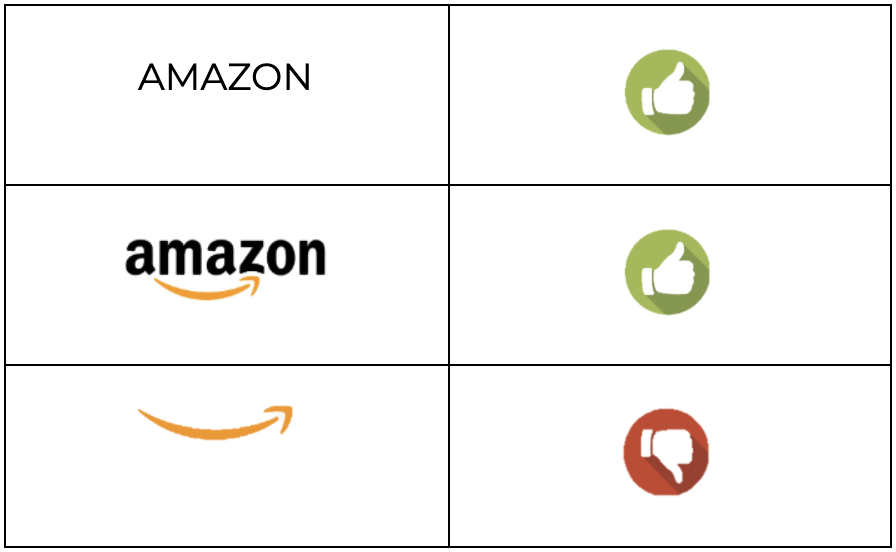
Finally, to be eligible for Brand Registry, Amazon will require the words in your trademark application to be an exact match to your registered brand name on Amazon. For instance, if your brand on Amazon is identified as JUPITER PLANET:
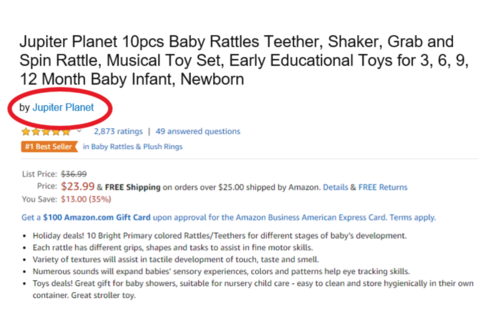
then, to qualify for Brand Registry, your trademark application must also be for JUPITER PLANET (unless you want to change your brand name on Amazon). JUPITERPLANET or JUPITER-PLANET would not be acceptable to Amazon.
Similarly, if you choose to file a design mark (discussed above), the lettering in the design mark must be an exact match to your registered brand name on Amazon. When we file a design mark application, we must claim all lettering in the design. As such, if we filed the logo below, the trademark office would identify the design mark as JP JUPITER PLANET:
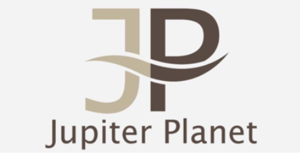
Sticking with the same example above, since the brand is identified on Amazon as simply, JUPITER PLANET, the above design mark would not be acceptable for Brand Registry purposes.
+ FAQ #4. Do I need be selling products on Amazon to use IP Accelerator?
No. You can apply for a trademark through IP Accelerator before you begin selling product on Amazon. How we proceed depends on whether you are currently selling products with the mark anywhere in the US. If you are currently selling products with the mark in U.S. commerce (i.e. via your website, Amazon, eBay, or any another e-commerce platform or storefront), we can file an “actual use” application because you are "actually using" the mark in commerce. Please see our FAQ #5 for more information about actual use applications. If you are not yet selling products in the U.S. but would like to begin the registration process, we can file an “intent-to-use” application. Please see our FAQ #6 for more information about intent to use applications.
+ FAQ #5a. What is an “Actual Use” application?
If you have already sold your branded products in the U.S., then we can file an "Actual Use" (AU) application because you are "actually using" the mark in U.S. commerce. What is (and is not) “actual use” is a legal term and is not always obvious. For example, if I want to apply for the trademark BUBBLETIME for soap products the following applies:
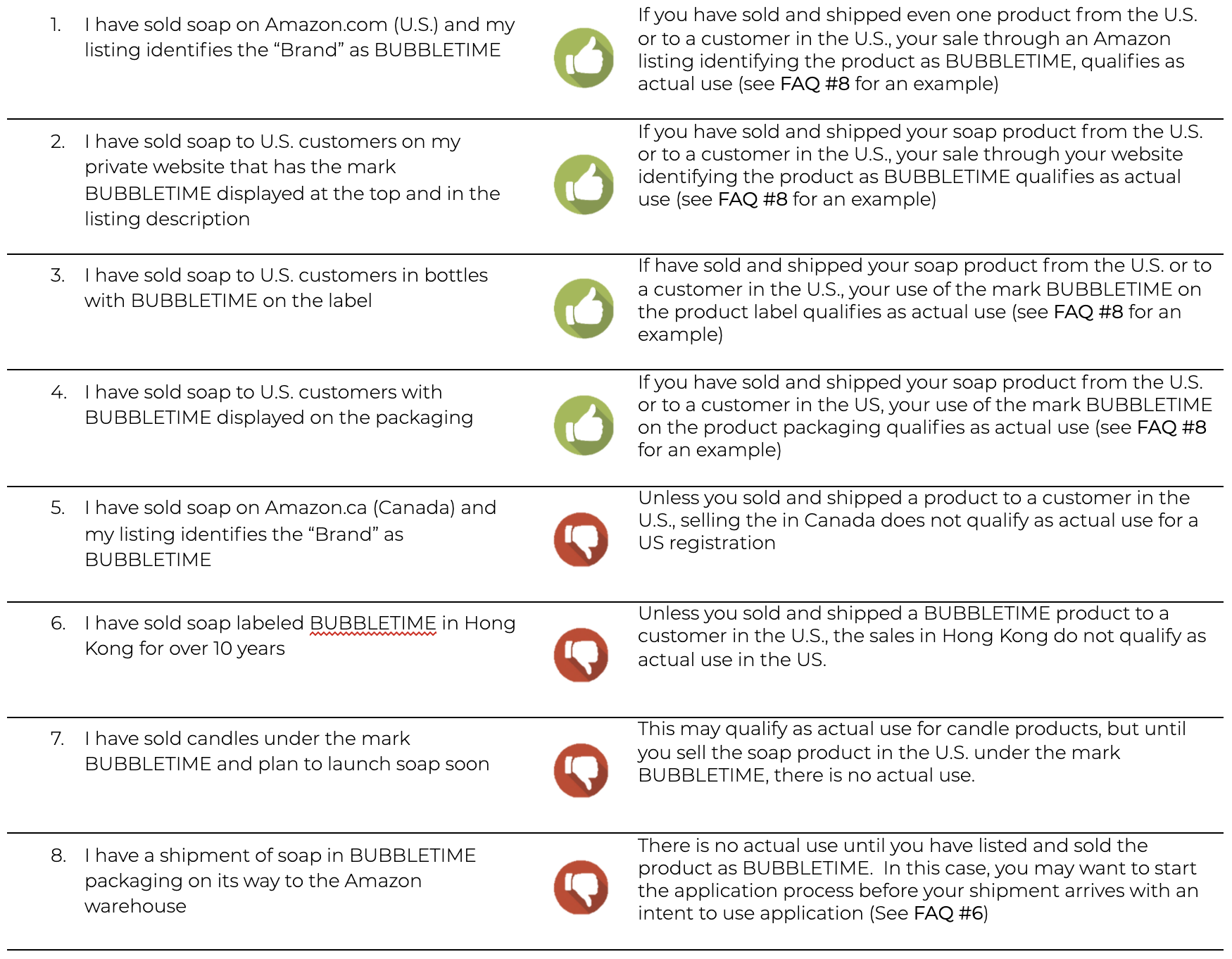
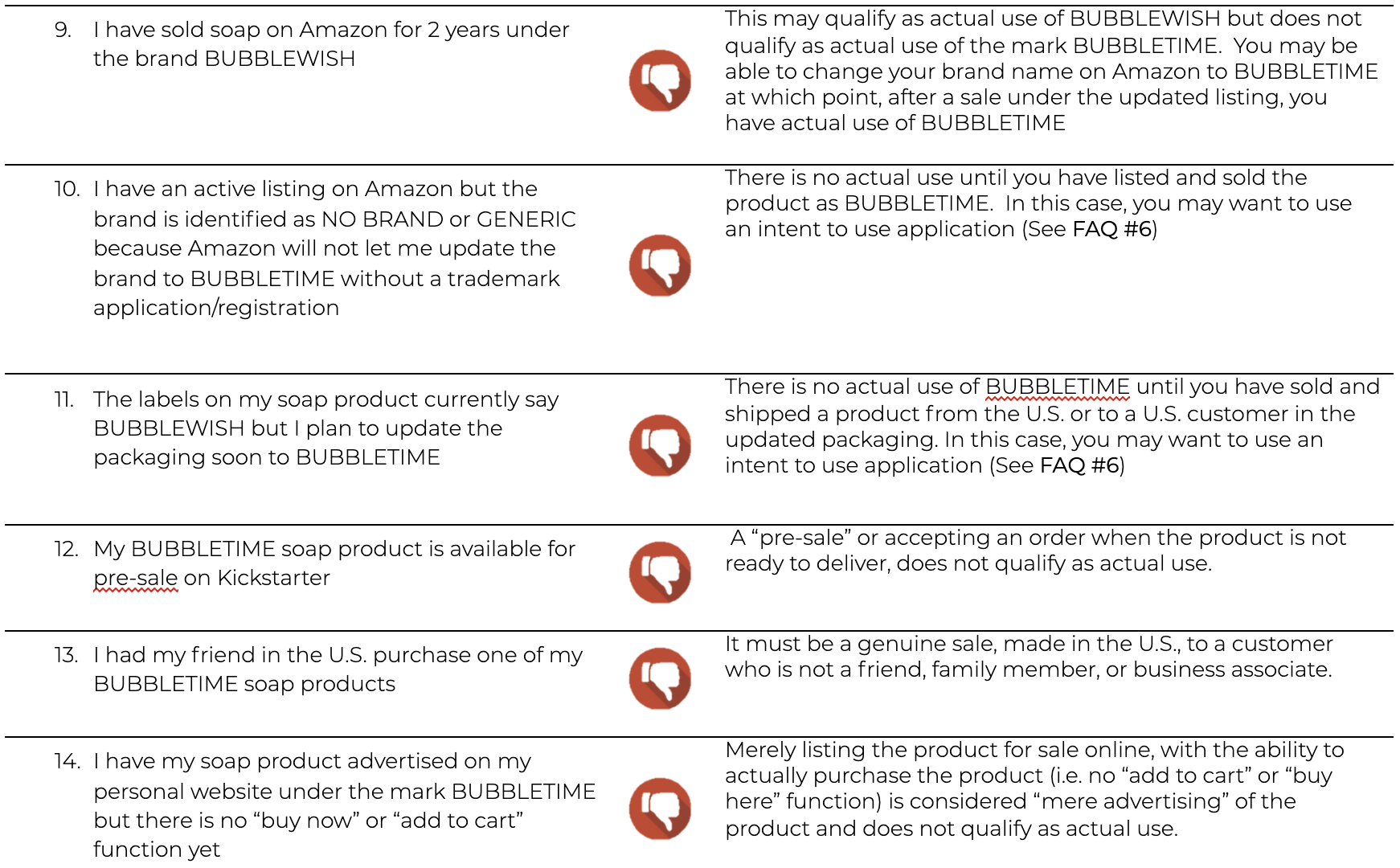
When we file your AU application, you will make a declaration, under oath, that the products listed in the application have been sold in US commerce, and you will be required to provide the dates of first sale. Accordingly, the AU application will list only those products you have actually sold as of the date of the application. If your application includes products not already sold, your entire application could be invalidated. If you do not meet the “sale” requirements of an AU application, it may be in your best interest to pursue an “Intent to Use” application. Please see our FAQ #6 for more information about Intent to Use applications.
Either way, using the methods outlined in FAQ #30, we will work together to determine the number of “International Classes” to include in your application. Our fees for standard description one-class to five-class AU application are:

- Note that a $200 USPTO per class Filing Fee Surcharge applies to applications with “custom” descriptions not found in the Trademark ID Manual, as explained FAQ #10b.
Please see our FAQ #10 for more information about fees and our FAQ #11 for details about what is included in the Service Fee.
+ FAQ #5b How do I prove Actual Use?
Actual use requires "use in commerce." The Trademark Act defines use in commerce as, “the bona fide use of a mark in the ordinary course of trade, and not made merely to reserve a right in a mark.” In other words, the sale must be genuine and not something done just to access the less expensive actual use application. There are times when a single sale may be genuine and other times where ten sales are not genuine. For instance, the USPTO said these types of sales are not genuine:
- Limited test run sales (creating a limited batch to sell quickly, solely so you can use the actual use application);
- Sales made to a friend, family member, or business connection for the sake of trying to prove use;
- Listing and selling one product on ebay or Amazon before the goods are generally available for shipment to public at-large; and
- Pre-sales on Kickstarter or other pre-sale platforms.
Conversely, if your products are stocked and genuinely for sale to the public at-large, and a customer purchases one of the goods, that one sale can be genuine and qualify as actual use.
Keep in mind that in an actual use application, you will make a statement, under oath, that the goods are genuinely for sale in US commerce. If the USPTO or one of your competitors can show your statement was false, your application is subject to cancelation or expungement. For a strong registration, acceptable to Amazon, it is important to base an actual use application on a genuine sale.
Once we have confirmed you have actual use of all the goods in your application, we will work together to get the “proof of use” for the application. Each application is unique, but we generally require all of the below:
Your Sworn Statement. You will give your declaration in the application, made under oath, that all products identified in the application have been sold in the US;
Dates of First Sale. We will need the date you first sold each of the goods identified in the application in the US; and
Proof of Use. We need to submit proof of your use of the mark via one of the options discussed below:
Option A:
- A link to an online listing of each product identified in the application, on a reputable US ecommerce platform such as Amazon or Walmart Marketplace, where the product is in stock and actively for sale;
Option B:
- A link to an online listing of each product identified in the application, on a self-branded website (i.e. Shopify) or self-listed platform (i.e. Ebay or Etsy); plus
- Two photos of each product identified in the application, with each photo showing multiple (three or more) of the same product or product packaging. For instance, these photos show three or more packages of the same product:

Option C:
- Two photos of each product identified in the application, with each photo showing multiple (three or more) of the same product or product packaging. For instance, these photos show three or more packages of the same product; plus
- Invoices showing sales in the U.S. of each product applied for

+ FAQ #6a. What is an “Intent to Use” application?
If you are not currently selling your products in the United States but would like to begin the application and Brand Registry process, we can file an “intent-to-use” (ITU) application. An ITU application is eligible for early entry to Brand Registry through the IP Accelerator program. Some benefits of an ITU application are:
An ITU application allows you to start the Brand Registry process before launch. This means, potentially, you will have registered your brand from the day your listing goes live.
An ITU application gets your mark in line at the USPTO, thereby preventing any after-filed applications that might cause “likelihood of confusion” (See FAQ #26 for more information about “likelihood of confusion”) and block your mark from being registered. Some sellers like to have the mark "in line" before they go live, especially if they have a unique mark.
If there is a question about whether you have actual use of your mark (See FAQ #5), an ITU application allows you the time you need to show proper use and create an acceptable specimen.
Some sellers don't have much of a choice. To file an “actual use” application (see FAQ #5), you must be already selling your branded products in the U.S. If the only place you intend to sell your product is Amazon, and Amazon will not permit you to list your product under your “Brand” without proof of filing an application, then your only real choice is to file an ITU application.
The ITU application is a two-step application where we first file the application (Step One), and then, at a later date, file proof of your use of the mark (Step Two). The fees for the standard description ITU application (Step One) are in the table below:

- Note that a $200 per class USPTO Filing Fee Surcharge applies to applications with “custom” descriptions not found in the Trademark ID Manual, as explained FAQ #10b.
+ FAQ #6b. What products can I include in my "Intent to Use" application?
Many times, figuring out which products to include in your application (or not) is the hardest part of the trademark application process. Many sellers create a brand with the intent to sell several, even hundreds of different products under their brand at some future time. And in many countries, you can “reserve” your trademark for entire categories of goods, even if you do not sell those goods. The trademark system in the United States is unique in that your trademark rights in a brand extend only as far as those products you can prove you are actually selling in connection with your mark. As discussed in FAQ #6a., with an intent to use application, we supply the “proof” in Step Two.
An ITU application can list up to as many products as you realistically intend to launch in the next 12-14 months.
Roughly 6-8 months after we file the application, assuming all goes well, the USPTO will issue a Notice of Allowance (NOA) triggering a six-month period in which you must file a Statement of Use (SOU) proving you are using your trademark in connection with the products identified in the application. We may be able to extend the time to prove use, but extension requests can quickly become expensive (FAQ #6c., Option 3). Therefore, you should list only those products in the application you realistically believe you will sell in the next 12-14 months, unless you are comfortable paying repeated extension fees.
Again, including products in the application simply to "reserve" them, but without any real intent of selling them, is not permitted under US law, and can be detrimental to your application for the following reasons:
The USPTO is suspect of applications that include several different products that are otherwise unrelated, so they apply greater scrutiny to review your application, which could result in unnecessary refusals.
Relatedly, the more products you list, the greater the chance of running into “likelihood of confusion” with another mark (See FAQ #26 for a discussion of “likelihood of confusion), blocking your trademark application. For instance, if you include “toothbrushes” in your application, and there is a prior similar mark out there for dental cleaning supplies, your application could receive a refusal because there is someone ahead of you selling similar products. Listing “toothbrushes” may be worth it if you have immediate plans to sell toothbrushes but is an unnecessary risk if there is only a remote possibility you will eventually include this product.
If another seller can show you are not selling or have no real intent to sell a product you claim to sell, the seller can move to cancel your entire application for "non-use."
The more classes, the more expensive the application. Our FAQ #30 provides an in-depth discussion about determining product classification. The additional classes, and added costs, are likely worthwhile for the products you actually intend to sell but would be a waste of resources if you are not likely to ever sell the product and will eventually have to delete them from the application, as discussed below (#6c., Option 2).
+ FAQ #6c. What happens after my "Intent to Use" application is allowed (Step Two)?
Again, roughly 12 to 14 months after we file the application (the “deadline”), if all goes well, we must proceed under one of the below “Step Two” options. As the deadline approaches, we will discuss which option is best for you at that time.
- Option 1 - File a Statement of Use (“SOU”) – All products. As soon as you are selling all of the products identified in your application, we can file an SOU in which you will declare, under penalty of perjury, that you are selling all product and we will file the necessary proof. In that case, you should receive registered rights in all products. The USPTO filing fee for the SOU is $100 per class covered by the SOU and IdeaLegal’s flat fee for preparing and filing the SOU is $400, so depending on the classes covered by your application, Step Two fees under this option are:

- Option 2 – File a Statement of Use (“SOU”) – Some products. If by the deadline you are selling some but not all of the products, and you would like to advance the application to the next phase of registration, we can delete those products you are not selling from the application and file an SOU for only those products you are selling. In that case, you should receive registered rights in only those products remaining in the application after deletion. The USPTO filing fee for the SOU is $100 per class covered by the SOU and IdeaLegal’s flat fee for preparing and filing the SOU is $400, so depending on the classes covered by your application, Step Two fees under this option are:

- Option 3 - File a Request for Extension (“RFE”). If you cannot show proof of use before the deadline, or if you want to wait to file the SOU until you are selling all (or more of) the goods in your application, we can file an RFE which will extend the deadline by an additional six months. You can request up to five RFEs. The USPTO filing fee for an RFE is $125 per class covered by the application, and IdeaLegal’s flat fee for preparing and filing the request is $300, so depending on the classes in your application, Step Two fees under this option are:

- Option 4 - Do Nothing. Perhaps your business plans will have changed. If we do not proceed with Option 1, 2 or 3 above, before the deadline, your application will be marked “abandoned.” Amazon has said it will remove brands from Brand Registry when it discovers the application has been marked abandoned. There are no additional fees under this option.
+ FAQ #7. What if I am selling some products now, but intend to sell more products in the future?
In the situation where you are selling some products now but intend to sell more products in the future, you have the following options:
- Option One: Cover Only the Products You are Currently Selling in an AU Application.
You can apply for registration of your mark now as to only those products you are actually selling, using the Actual Use Application (see FAQ #5). Under this option you can join Brand Registry shortly after we file your application, and you will not incur the extra cost of an ITU application.
You will have the opportunity to add your future products to your Brand Registry account when you begin selling them on Amazon. If you want full trademark protection for future products, you can file a second trademark application. The cost of a new application will be the same as any new application at the time you file, likely similar to the costs of a new application today. Amazon will not require you to have a separate trademark registration for your future products when you add them to your Brand Registry account. However, Amazon will look to see whether you have a trademark registration for certain goods when you ask Amazon to remove potentially infringing listings.
For example:
- If you currently sell bath toys and bath sponges under the mark BUBBLETIME, and we apply for a trademark registration for these products, you can join Brand Registry for the brand BUBBLETIME shortly after we file your application.
- If, six months from now, you begin selling soap under the mark BUBBLETIME, you can add your soap product listings to your BUBBLETIME Brand Registry account without proof that you have a trademark registration that covers soap. You would get most of the Brand Registry benefits for your soap product including brand representation, search tools, and brand building benefits. However…
- If, a year from now, you discover another Amazon seller selling bath toys, bath sponges, and soap under the mark BUBBLETIME, and you ask Amazon to remove the listing as infringing your trademark. At that time, Amazon would review exactly which products are covered by your trademark registration(s). Since you only have a registration covering bath toys and bath sponges, Amazon would enforce your rights as to those products but may choose not to enforce your rights as to the soap products.
- Option Two: Wait Until You Are Selling All Products and Cover Them All in an AU Application.
You could wait until you have launched all future products and file an Actual Use application at that time, covering all products. You can join Brand Registry shortly after we file the application, whenever that may be.
- Option Three: File One Application AU for the Products Are You Selling, and ITU for the Future Products.
You could file an application that covers the products you are currently selling on an Actual Use basis (FAQ #5), and the products you intend to launch in the next 12 months on an Intent to Use basis (FAQ #6).
- We would file an application now with bath toys and bath sponges as AU and soap as an ITU. The fees for filing the application are the same as any other application (detailed at FAQ #10). Under this option you can join Brand Registry shortly after we file your application and all products will be covered.
- Once you begin actually using the mark in commerce for soap, you have to file a “Statement of Use” (SOU) proving your use of the mark in commerce (FAQ #6). Our fee to prepare and file a SOU is $400 and the trademark office charges a filing fee of $100 per class covered by the application. We can file the statement of use as soon as you start selling products with the mark, or we can wait up to about one year after we file the application if you prefer to spread out the cost. We will only invoice for the application fees at this time. We will invoice for the SOU fees when those services are rendered.
- The trademark would eventually register as to all products (bath toys, bath sponges and soaps).
- You would have full Brand Registry protection for all products (bath toys, bath sponges and soaps), including enforcement.
If the idea is to get onto Brand Registry as quickly as possible, and to keep costs as low as possible, we suggest Option 1.
If you are close to launch of all future products and quick access to Brand Registry is not an important factor for your business, we suggest Option 2.
If you can afford to have as much trademark protection as possible, we suggest Option 3.
+ FAQ #8. What is a "Specimen"?
At the time we file an application (see FAQ #5) or a Statement of Use (see FAQ #6) we must file a “specimen” proving use of your mark on the goods identified in the application. We can prove use by submitting photographs of the mark on the products themselves, product packaging, or an online listing properly identifying the mark. Amazon will also require photographs of your mark on the product or product packaging when enrolling in Brand Registry.
It is important to note that a digitally created mockup of a label or packaging will not be accepted by the USPTO. In other words, you must provide a photo that is not digitally altered in any way (do not remove background or edit color).
Example: If you applied for the mark MAMA BEAR (word mark) and/or
 (design mark), for baby wipes, the following apply:
(design mark), for baby wipes, the following apply:
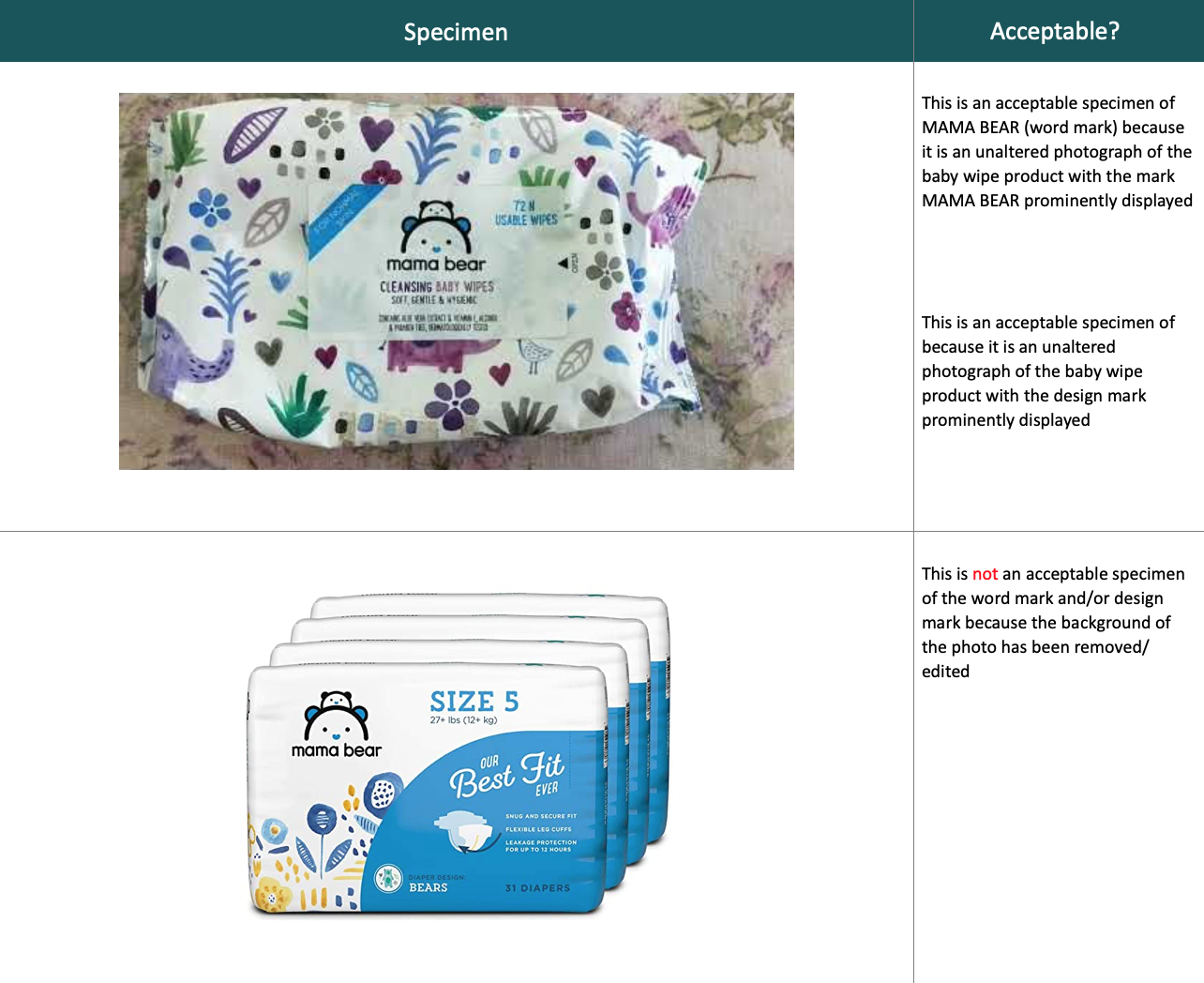
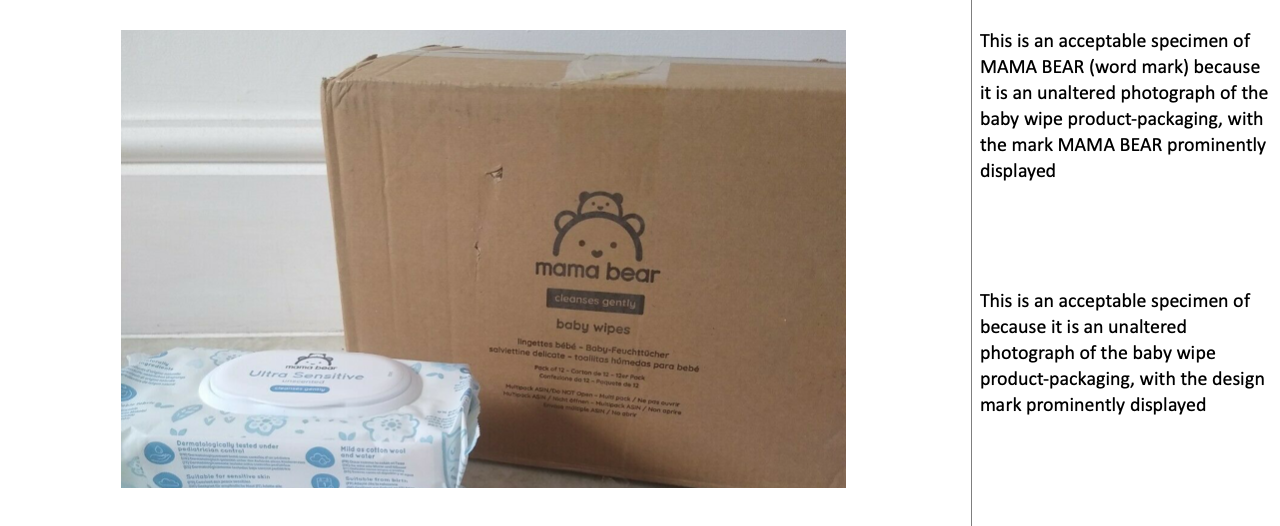
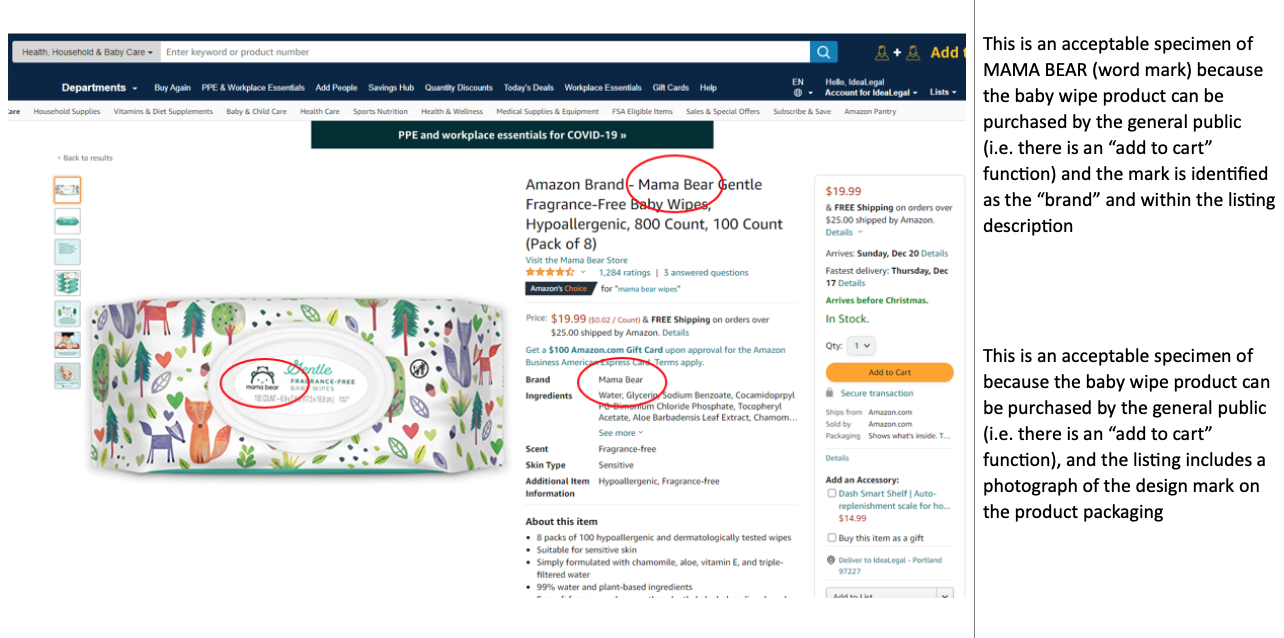
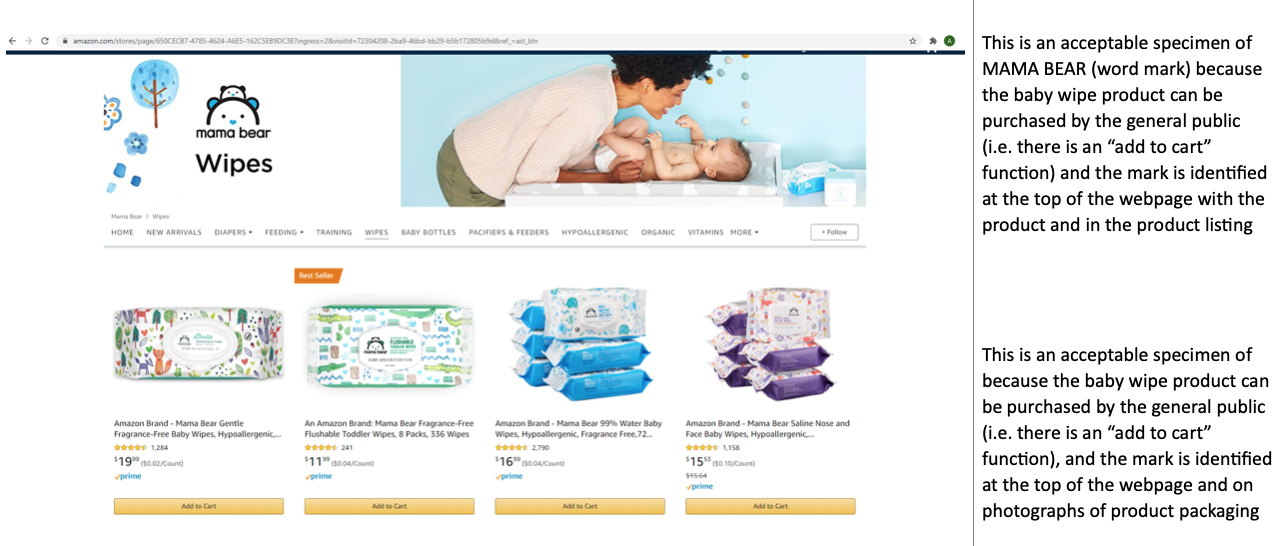
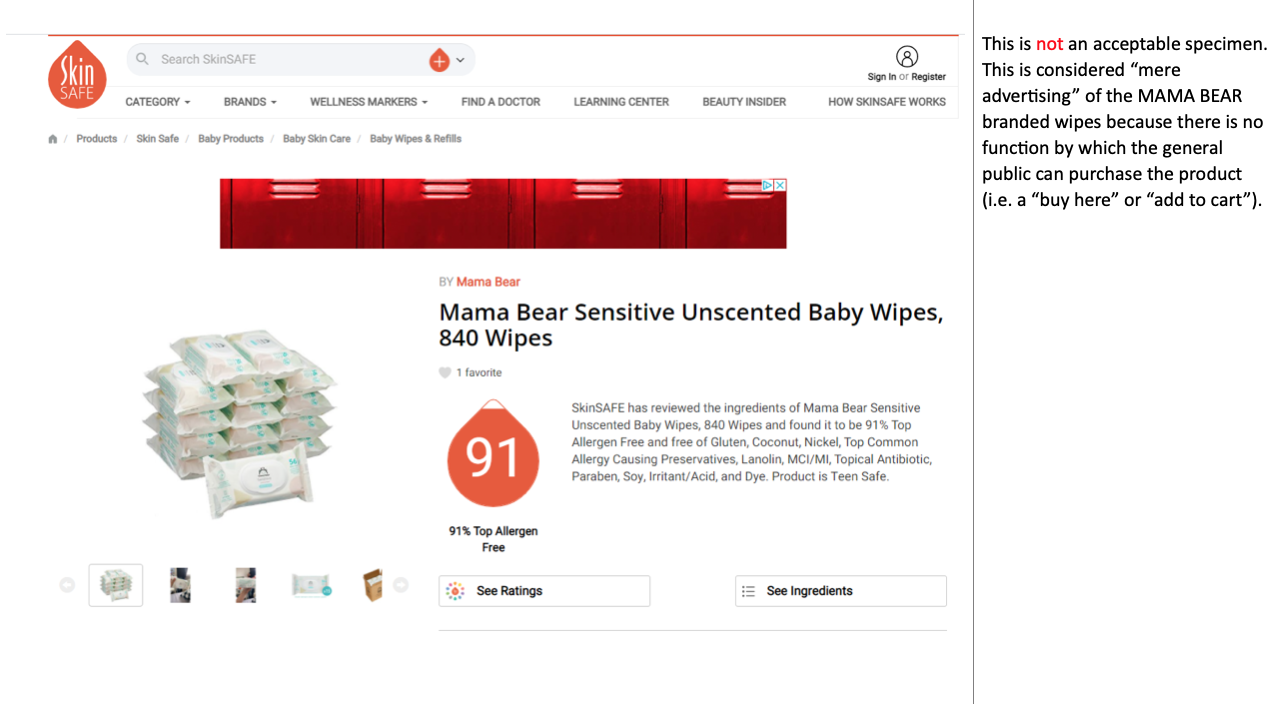
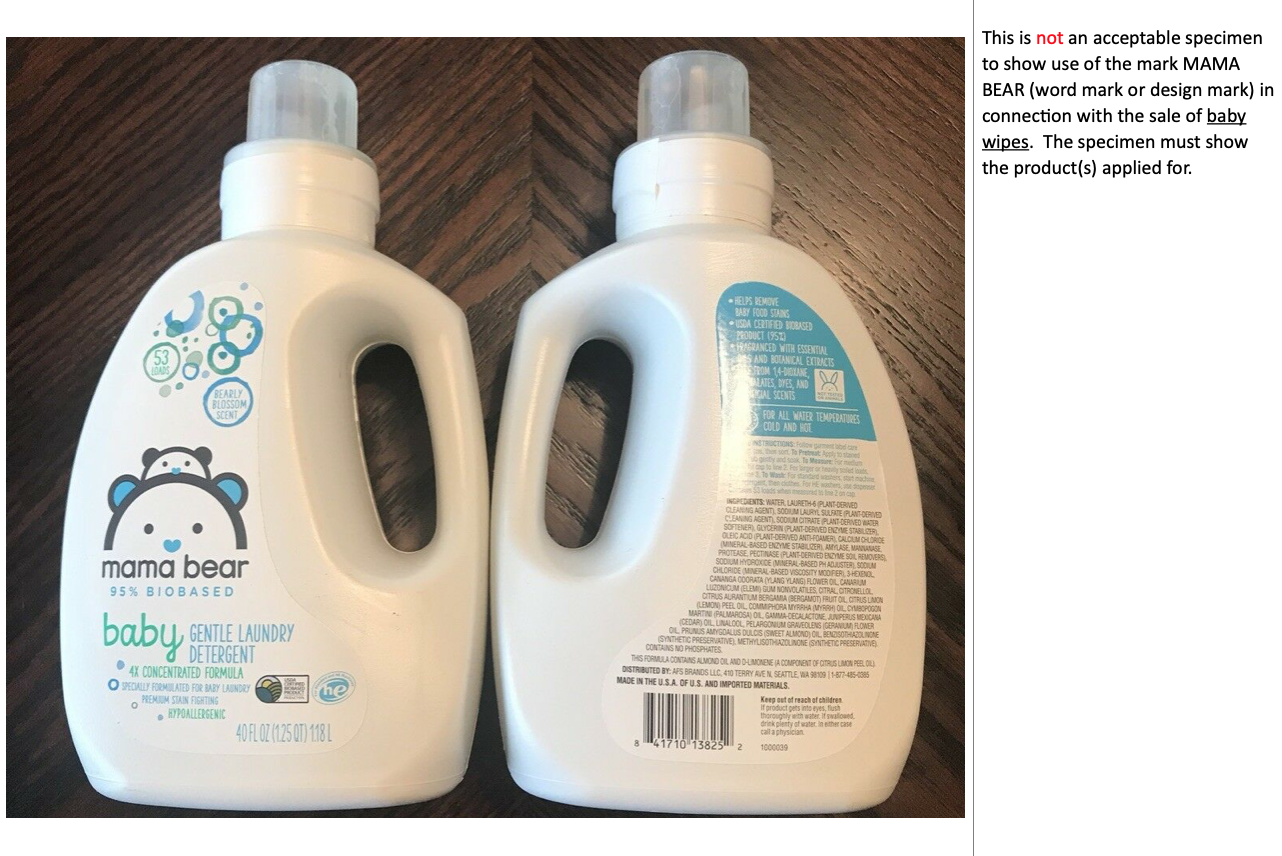
+FAQ #9a. What is a trademark search and do I need one?
The primary purpose of a trademark search is to determine whether a mark is available for use and registration, or whether there are other marks that may block your proposed use or application of the mark based on “Likelihood of Confusion” (LOC). Please see our FAQ #26 for a detailed discussion of LOC. You are not obligated to search for potentially conflicting marks before applying for registration, and Amazon does not require it. However, if you file an application without a search, you risk having the application denied for reasons that could have been discovered in a search.
Please note that if your application is refused by the trademark office and you are forced to abandon your application, you will eventually lose access to Brand Registry and the application fees paid to our firm and to the trademark office will not be refunded. Additionally, Amazon has stated that if it detects multiple abandoned applications by a single seller, it will remove the seller from Brand Registry for abuses. So it’s important to try to get it right the first time.
We offer three types of trademark search services:
High-level Search: This search provides a high-level (overview) brand search of USPTO records for relevant pending applications and registrations and provide an opinion based on our results. This search is limited to trademark records at the USPTO but gives us a clearer picture of whether or not your mark will register at the USPTO. If you proceed with a high-level search, we will send you an engagement letter and invoice for the service. We aim to provide search results within three business days of receiving the signed engagement letter and paid invoice. We off the high-level search for a flat fee of $500 per search.
In-House Comprehensive Search: This search provides a comprehensive search of registered marks (USPTO Records) and unregistered uses (online and business listings). We analyze the results and provide you with a report of potential obstacles (or not) to registration of your mark as well as "common law" uses outside of registration (this is further explained in the report), which may tell you if there’s a risk of receiving a “cease and desist” letter from a competitor, even if they haven’t registered the trademark. We aim to provide search results within seven business days of receiving the signed engagement letter and paid invoice. We offer the in-house comprehensive search for a flat fee of $1,200 per search.
Vendor Comprehensive Search: This search is performed by an outside vendor with the ability to search everything offered under the In-House Comprehensive Search + state trademark records. If you proceed with a vendor comprehensive search, we will send you an engagement letter and invoice for the service. Once we receive the signed engagement letter and paid invoice, we will order the search from our vendor. The vendor generally provides results within three business days. We will then review the results and provide our report to you within seven business days of receiving the vendor results. We offer the Vendor Comprehensive search for a flat fee of $1,800 per search.
Our search services and fees are separate and in addition to the application fee. The search fees discussed above cover the search of one trademark. We may be able to search minor variations of a mark within the same search (i.e. FUZZY BLANKETS as well as THE FUZZY BLANKET or A FUZZY BLANKET), but variations in distinctive portions of the mark require separate searching. For instance, a search for THE FUZZY BLANKET would produce much different results (and require separate analysis) from THE COMFY BLANKET. If you are considering several marks, we suggest you do some preliminary searching on each mark, as discussed in our FAQ #9b, and then we can confirm the availability of the mark you like the best using our special software and expertise.
+FAQ #9b. Can I search my trademark on my own?
As discussed at our FAQ #9a, a clearance search by our firm is not required and you can opt to perform a search on your own. Our FAQ #26 provides a discussion about “Likelihood of Confusion” (LOC) you can use this as a guide in your search, but it is important to note that determining whether two marks may create LOC requires some legal knowledge, analysis, and experience.
Importantly, the trademark office may refuse your application based on prior-filed trademarks with different spellings, spacing, pluralization, words in different order, translations to other languages, and phonetic equivalents, so a trademark search is considerably more complicated than looking for the exact same trademark as yours.
Many clients find a concerning mark on their own and ask that we provide a “quick” opinion or analysis, but except for the most obvious cases of LOC (like an exact same mark covering the exact same goods), we cannot provide a legal opinion without first performing a search as outlined in our FAQ #9a. To provide this kind of legal opinion requires us to first research:
- how similar marks have been treated by the USPTO in the past;
- how common a shared word or phrase is within a particular industry;
- whether a shared word or phrase has any particular meaning or significance as it relates to the goods sold under both marks;
- where the goods have been treated as related or unrelated goods in prior applications; and
- who has prior use of a mark.
If you have done your own searching and feel reasonably confident the mark is available (considering that non-identical marks can be cited against yours!), you can choose to accept some risk and just go straight to the trademark application stage. As a best practice, however, we advise all clients to invest in one of the search options outlined in our FAQ #9a.
+FAQ #9c. There is another mark at the USPTO that is almost identical to mine. How do I proceed?
We know how alarming it can be to discover someone else is using a mark that is the same or nearly the same as yours (we call these “similar” marks), especially if you have already invested time and effort developing your brand.
If we perform one of the searches outlined in our FAQ #9a, and our search discovers similar mark(s), our search report will provide you with detailed and specific options for proceeding so this type of analysis is already included in the fee.
If you opt to perform the search on your own as discussed in our FAQ #9b, and you find a concerning mark, you have the following options:
Option 1: Get a Legal Opinion: If you like, we can perform one of the searches outlined in our FAQ #9a, which will, (a) confirm or deny your concern, based on evidence, (b) identify and report other potentially similar marks (if any) and, (c) provide you with detailed and specific options for proceeding.
Option 2: Choose a New Mark. You always have the option of choosing another mark. Unfortunately, our office does not provide any “name generation” services and without performing a search as outlined in our FAQ #9a, we won’t be able to tell you whether your new mark is “clear” for registration. If you have any doubts, you may want to have the mark searched first, as discussed at our FAQ #9a.
+ FAQ #10a. What are the fees for an application?
The total cost to file a US trademark application depends on two factors:
Whether you file an “Actual Use” application, or “Intent to Use” application (Please review our FAQ #5 for more information about Actual Use applications, and our FAQ #6 for more information about Intent to Use applications); and
The number “International Classes” included in your application. (Please see our FAQ #30 for information about properly classifying your products).
All applications are comprised of two fees:
Our pre-negotiated Service Fee for those services outlined in our FAQ #11; and
A Filing Fee (sometimes called a government fee) charged by the United States Patent and Trademark Office.
Actual Use Applications
If you file an Actual Use application the following Service Fees and Filing Fees apply based on the number of International Classes covered by your application:

Intent to Use Applications
As discussed in detail at our FAQ #6, if you file an Intent to Use application, it is a two-step process where we first file the application (Step One), and then, at a later date, file proof of your use of the mark (Step Two). Fees are incurred at Step One and Step Two as follows:
STEP ONE – File the Application: If you file an Intent to Use application the following Service Fees and Filing Fees apply based on the number of International Classes covered by your application:

STEP TWO - File Statement of Use: If all goes well, roughly 6 – 8 months after we file your Intent to Use application, the USPTO will issue a Notice of Allowance which will trigger a six-month deadline by which you must file a Statement of Use (SOU) proving you are using your trademark in connection with the products identified in the application. The following Service Fees and Filing Fees apply for the SOU, which will be invoiced at the time we prepare the SOU:

If you have not started selling your products and cannot prove use of your mark before the SOU deadline, we can file a Request for Extension (RFE) which will extend the deadline to file your SOU by an additional six months. We can discuss what option is best for you as the deadline approaches but if you decide to request the extension, the following Service Fees and Filing Fees apply for the RFE, which will be invoiced at the time we prepare the RFE:

+ FAQ #10b. When does the surcharge for “custom” goods descriptions apply?
Although the filing fee for a standard one-class application is $350 per class, the USPTO recently introduced a $200 “surcharge” for custom goods and services descriptions. “Custom” descriptions are those that cannot be found in the list of preexisting descriptions in the Trademark ID Manual (TMID). These are products that, for whatever reason, the USPTO has not yet pre-described.
For example, “Cosmetic apparatus for microdermabrasion” can be found in the TMID and the USPTO filing fee would be $350. But “Cosmetic apparatus, namely, electric blackhead removal tool for use on skin” is not in the TMID and the USPTO filing fee would be $550 for this product. There is no way to describe this tool in a way that fits the TMID. This will be the case for some products. We will do our best to describe your products according to the descriptions in the TMID, to save you money, but please understand that certain products are not yet described there, and if your product is one of these, the surcharge will apply.
+ FAQ #11. What is and not included in the flat fee application cost?
The application flat fee includes:
- The steps outlined in FAQ #2 for preparing and filing an application based on the information you have provided to us;
- Reporting your serial number to Amazon;
- Reporting any verification codes required for Brand Registry enrollment;
- reporting the publication of your application; and
- reporting the registration of your mark, and sending you an electronic certificate of registration.
The flat fee does not include:
- Searching the availability, or commenting on the availability, of your trademark (see FAQ #9);
- Telephone consultations—these can be arranged by appointment only and will be invoiced at our hourly rate of $400 per hour;
- Assistance with Brand Registry enrollment other than the services outlined above (see FAQ #16);
- Filing change of information forms such as changes to the owner name or address (see FAQ #20)
- Receiving the paper copy of your certificate—if you would like us to mail you the paper trademark registration certificate, you can let us know when we report your registration and pay a fee of $15 for mailing service;
- Reporting, researching, and responding to office actions (see FAQ #12);
- Enforcing your trademark rights on Amazon or elsewhere;
- Negotiations or dispute resolution; or
- Litigation, including opposition and cancellation proceedings.
+ FAQ #12. What happens if my application is refused?
The trademark office reviews each application to determine if it qualifies for registration and can refuse registration on a variety of grounds by issuing an Office Action. We use our experience and professional judgment to try to avoid Office Actions, but Office Actions are not infrequent, and, to a degree, we have little control over the trademark office's decision to issue an Office Action. This is especially true when the applicant has elected not to have a professional search and clearance of the mark performed, to assess its risk before proceeding.
Some Office Actions are primarily technical in nature and will not significantly affect the scope or your trademark rights. For instance, an examining attorney might suggest a clarifying word to the goods description or ask that we “disclaim” (see FAQ #24) a word that is objectively descriptive or generic. In those instances, we will respond to the Office Action on your behalf without involving you in the process and at no additional cost to you.
Most Office Actions require a more substantive review and response, and we perform these services at our hourly rate of $400. If a substantive Office Action issues, we will forward the Office Action to you and report some options and the next steps generally available. Because of the expense, we will not then perform any of the services outlined in our reporting email without first obtaining your consent.
Importantly, our reporting email will not provide any analysis or advice about which option is best for your particular situation. This is because we have not yet analyzed the office action in any detail, researched the strength or validity of the refusal, or, when necessary, investigated the owner’s use of the marks cited against you. Again, these are services performed at our hourly rate and therefore will not be performed without your consent. In almost every situation, we will suggest you start with research services first, so we can better understand your position and provide advice on your best option for proceeding. Without researching the issue first, we simply do not know which option is best for you. Depending on the nature of Office Action, research can take anywhere from 1 -2 hours ($400 - $800). Once we properly research your position, we will provide an opinion report laying out the strengths and weaknesses of the refusal along with targeted advice as to which option we recommend in your situation.
Again, the best option for your situation depends on the particulars of your mark and grounds for refusal. But these are some options that may be available to you:
Respond to the Refusal. You have the option of challenging the refusal with argument and evidence. Depending on the basis of our argument, and whether it is necessary to prepare and attach evidence, a challenge to the refusal can take anywhere from 1 to 5 hours ($400-$2,000). We will have a better idea of the cost once we preform the research discussed above.
Seek Consent. When your mark is refused registration based on “likelihood of confusion” (FAQ #26) our opinion report may suggest you ask the owner(s) of the cited mark to consent (agree) to the registration of your mark. If they agree, we will prepare a “consent agreement” and ask them to sign it, and then file the consent agreement with the trademark office as part of an office action response. Consent agreements almost always convince trademark examiners to drop the refusal and let your application proceed. Generally, it takes about 3 hours ($1,200) to reach out and seek consent and, assuming consent is given, to prepare a consent agreement, get it signed, and submit it to the trademark office.
Attempt to oppose or cancel the cited marks. When your mark is refused registration based on “likelihood of confusion” (FAQ #26) our opinion report may suggest you file a Notice of Opposition or Petition for Cancellation (the appropriate filing depends on where the cited mark is in the registration process) which, if successful, would clear the path for registration of your mark. Filing a Notice or Petition, and then (hopefully) negotiating a settlement permitting your application to proceed, can take anywhere from 3 hours of attorney time (usually when the owner of the cited mark does not appear to defend its application/registration) to 20+ hours of attorney time if the proceeding is strongly contested. In addition to attorney’s fees, the USPTO filing fee for a Petition is $600. We will have a better idea of the cost once we preform the research discussed above.
Refile a different type of mark or product. Our opinion report may conclude that your best option is to refile the application for a different type of mark (i.e. refile a design mark instead of a word mark) or to refile the application for the same mark covering a different product. In that case, the cost is the cost of filing a new application (Please see our FAQ #10 for current pricing information).
Make no response and rebrand. You may decide on your own, or based on our research findings, that you do not want to put any more resources into your mark and opt instead for a rebrand. From a trademark perspective, the cost of rebrand is the cost of filing a new application (Please see our FAQ #10 for current pricing information). Our reporting email will provide you with advice on how best to time a rebrand so that it does not disrupt your Brand Registry.
If you decide not to respond to the office action, or if the response is successful and you decide not to contest it further, the application will eventually (within a few months) be marked as “abandoned” in the trademark office database. Amazon has said that it will regularly monitor the status of a participant’s trademark application and if a trademark application goes abandoned, that application will no longer have access to Brand Registry benefits and automated brand protections. We do not know how often Amazon performs these reviews. You can mitigate the risk of a “likelihood of confusion” (FAQ #26) refusal by thoroughly researching whether your mark is available or asking us to perform a search as described in FAQ #9. or asking us to perform a search as described in FAQ #9.
+ FAQ #13. Can I add new products to my trademark after the application is filed?
If you have already filed your first trademark application and then want trademark protection for new goods in the same class or new classes under the same brand, you will need to file a new trademark application at the costs outlined in FAQ #10. The trademark office does not let you tack on new products or classes to an application after it has been filed. This is because the trademark office examines your application for a likelihood of confusion with prior marks based on the set specific goods in the application. If the product is in the same class, though, it may be “related” to the products listed in your first application, thereby giving you sufficient protection without needing to pay more (i.e., if you registered your brand for blankets and are now selling sheets, you would not necessarily need to file another trademark application because it is common for the same seller to offer both blankets and sheets).
+ FAQ # 14. I already have a trademark application or registration; can you take over as the attorney?
The short answer is, maybe. Unlike most trademark systems throughout the world, trademark rights in the United States extend only as far as the specific goods you have sold (or intend to sell) with the mark (see FAQ #28 for a detailed discussion). You may not realize it, but if you filed your original application as “actual use,” you made a declaration, under oath, that all of the products identified in the application were already sold in the United States. If your application covered products you were not actually selling at the time you made the declaration, then the application is void ab initio and is subject to cancellation or expungement. As attorney of record, it is our job to ensure that clients understand these rules and that all statements in the application are accurate. As such, before we take over any application or registration, we must ensure the registration was accurate and complies with US trademark law. This is necessary to maintain our good reputation at the USPTO and Amazon. We will first send you a questionnaire aimed at gathering all the important information we need to determine if we can take over the application.
If we determine all information in the original application or registration is accurate: We can take over as attorney of record. We charge a flat fee of $300 to take over an application or registration not filed by our firm. This flat fee covers reviewing the USPTO file; preparing and filing a substitution of attorney form at the USPTO; forwarding Brand Registry verification codes as they are received; and docketing, monitoring, and providing certain maintenance filing (renewal) notices.
If we are unable to confirm all information in the original application or registration was accurate at the time of filing: We cannot take over as attorney of record. We can, however, file a new application covering those goods that you are actually selling with the mark, or genuinely intend to sell with the mark. We will discuss those options by email after we review your questionnaire.
Importantly, our taking over an application or registration does not guarantee the USPTO will allow your mark and/or that Amazon will permit Brand Registry. This is a risk with which you must be comfortable should you choose for us to take over your application or registration. If you are uncomfortable with this risk then you may consider filing a new application with our firm where we submit your brand to Amazon for Brand Registry enrollment through the IP Accelerator Program (see our FAQ #1 for a discussion of the IP Accelerator program). IP Accelerator is only available for newly filed applications.
+ FAQ #15. I have several brands I would like to apply for trademark protection; do you offer bulk pricing?
No. We are sorry to say that the pre-negotiated Amazon rates are already considerably lower than our rates outside the IP Accelerator program and we cannot reduce them any further.
+ FAQ #16. What if I encounter issues with Brand Registry enrollment?
As detailed at FAQ #11, our flat fee covers reporting your serial number to Amazon and reporting any verification codes required for Brand Registry enrollment.
Except for the two services described above, we have very little insight into the Brand Registry onboarding process. You will need to work directly with Amazon for Brand Registry enrollment. We are an independent law firm that is not affiliated with Amazon. Amazon has approved our firm for its IP Accelerator program (i.e., Amazon trusts our work and knows that if clients work with us they can be enrolled in Brand Registry earlier), but we do not work for Amazon or administer the Brand Registry program.
While most clients report an easy onboarding process, we understand that, at times, brand registry enrollment can be a frustrating process. If it were up to us, we would reach into Amazon’s system and quickly resolve any issue you are facing. But we have no access to Amazon’s internal systems and no ability to enroll your brand. Instead, Amazon has instructed us to tell sellers to reach out directly to Amazon at http://www.amazon-brand-registry.com/eng/contact_us and follow the prompts.
While we wish there were another way, if you reach out to us with questions regarding the enrollment process, we will ask you to contact Amazon directly at the link above.
+ FAQ #17. Does filing a trademark application with your firm guarantee me access to Brand Registry.
We are an independent law firm that is not affiliated with Amazon. As discussed at FAQ #1 Amazon has represented that you will have early access to Brand Registry benefits if you file a trademark application with our firm (http://www.amazon-brand-registry.com/eng/contact_us). But when and how you are ultimately accepted to Amazon’s Brand Registry program is solely under Amazon’s control and we do not make any guarantees on Amazon’s behalf.
+ FAQ #18. Why do you talk about my trademark using CAPITAL LETTERS?
It is standard practice in the United States to use all capital letters when we file a trademark application. Capitalization in a trademark registration means that you are not limited to any particular case or font style. It leaves you open to use those letters however you like including a mix of Caps and lower case.
The USPTO will always identify a trademark in its database in all capital letters. As such, we also always identify the mark in the USPTO filing in all capital letters. This does not have any effect on the capitalization (or not) you choose to use on Amazon or anywhere else.
Amazon itself is a great example of this. As you likely know, Amazon identifies its brand on the Amazon platform as “Amazon” (a mix of upper- and lower-case letters):
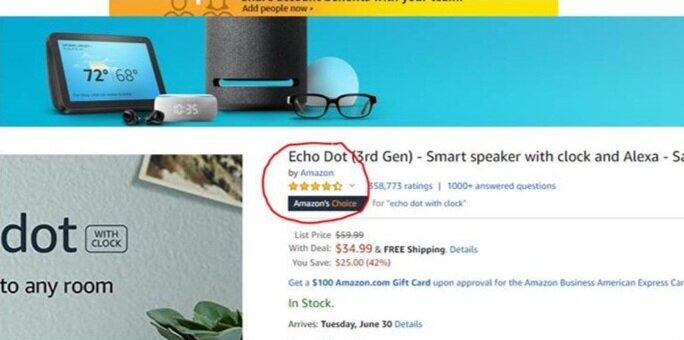
However, Amazon’s trademark registrations are all identified in the USPTO database as AMAZON (all caps). For instance:

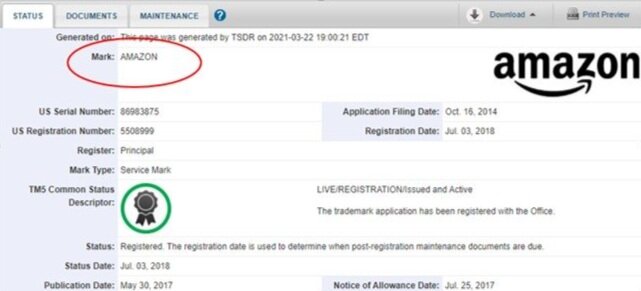
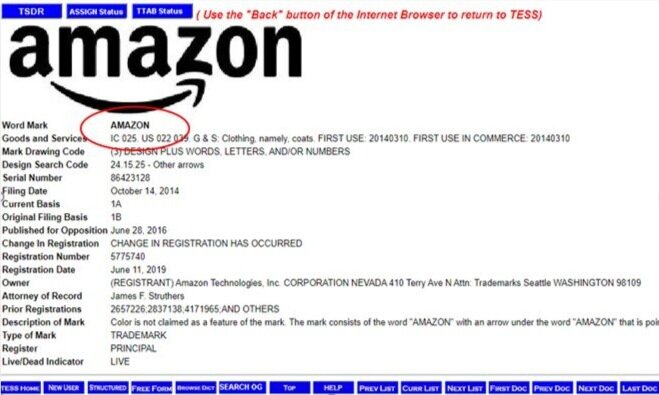
When we file your application, we will do so using all capital letters. Amazon has said it will permit the seller to specify the capitalization of its brand on the Brand Registry end, when you self-enroll.
+ FAQ #19. Is it better to use my personal name or my business name in the application?
The trademark application should be in the name of the individual or entity who owns the rights in the mark, whomever you consider that to be. There are no advantages or disadvantages one way or the other, from the standpoint of the trademark office or Amazon. There may be business or tax advantages, but we do not have expertise in those areas. Those questions should be discussed with your business and tax advisors.
Note: the name on your application and the name on your Amazon account do not need to match. Amazon may inquire about the relationship between the two, but it is acceptable if they are different (and is quite common).
+ FAQ #20. Can I change my name or address after I file the application?
Yes. Updating information listed in your application is handled differently, depending on the information updated:
Updating your address: Updating your address is a straightforward matter but it must be filed by the attorney of record on the application (that’s us!). If you attempt to file the change of address on your own, the UPSTO will reject the filing since you are not attorney of record. We charge a flat fee of $100 to file a change of address form.
Updating your name, or changing from individual to company: When you apply for a trademark in one name (whether it be an individual or a company) and you later want to transfer the trademark rights to a different individual or company, you will need to assign and record the transfer of rights as follows:
Step 1: Assign the Rights by Written Assignment. Step one is to assign ownership from one party to the other by a written assignment. The written assignment requires specific language to be a valid transfer of trademark rights and a signature of the transferring party.
Step 2: Record the Assignment. Similar to the process of purchasing a home, you have to record the assignment document so it becomes part of the public record. The assignment document is recorded at the USPTO and becomes part of the official trademark record.
Our flat fee to prepare the assignment document and record the same at the USPTO is $500 and the USPTO filing fee is $40-$100 (depending on how many marks are transferred by the same document).
As you can see, making a name change is not a simple or inexpensive process. As such, if timing allows you to make the name change before you file the application, we suggest you make the change first.
+ FAQ #21: Can I apply for several products under Class 35?
The availability of a Class 35 application is commonly misunderstood and something the USPTO has been cracking down on recently.
Class 35 is reserved for sellers offering "retail services" under their mark. As an example, if you sell bath products under the mark BUBBLETIME, and you have your own website with the mark BUBBLETIME, you are providing online retail services under the mark. Similarly, if you have a store front at a mall or farmer's market with the store front as BUBBLETIME, you are providing retail services under the mark. Conversely, if you merely sell BUBBLETIME-branded bath products on a third-party e-commerce platform (i.e. Amazon, eBay, Etsy) or third-party store front (i.e. Target or Shop-N-Save), you are selling goods under the mark; you are not providing retail services under the mark.
We have seen the USPTO push back on Amazon sellers who try to classify their goods as a Class 35 service.
If you sell your goods though a third-party retail outlet (i.e. Amazon or target) and on your own branded website, then you have the option of filing an application covering the goods themselves and/or a Class 35 application covering retail services. A registration in the individual goods gives you registered trademark rights in the goods themselves. This means you could potentially prevent other sellers from using a confusingly similar mark to sell similar products. A registration in the retail services give you registered trademark rights in the retail services, not the goods themselves. This means you could potentially prevent another seller from offering an online store with a similar mark selling similar goods but not necessarily against another seller selling a particular good under a similar mark. Amazon itself is a good example to highlight the difference. Amazon has trademark rights as an on-line retailer selling several different goods (Amazon’s Services). As such, Amazon can stop another online e-commerce platform from using a mark similar to AMAZON. However, Amazon could not necessarily prevent another company from using the brand AMAZON to sell, for example, soap. Amazon also has trademark registrations in AMAZON-branded goods, like its speaker products (Amazon’s Goods). This means Amazon can prevent another seller from selling speaker products under a mark similar to AMAZON. The biggest benefit of a Class 35 registration is that it is a one-class application, so it is less expensive than a multi-class application (see FAQ #10 for fees) if you sell products across several international classes. A Class 35 application is acceptable for Brand Registry. The biggest drawback to a Class 35 registration is that if you ever need to enforce your rights against another seller for a particular product, Amazon may decline to do so if you only have registered rights in your online retail services and not the goods themselves. If the idea is to get onto Brand Registry with the least amount of cost, then Class 35 may be the way to go. If the idea is to have broader, enforceable trademark rights, then we suggest you file for the goods themselves.
+ FAQ #22. Will my personal information and address be made public?
The USPTO requires us to name the applicant (which may be a company or an individual, per FAQ #19), and that application must be signed by the applicant or its authorized representative. So these two pieces of information are, by necessity, part of the public record, for those who know how to search for it in the USPTO database. With respect to your address, however, although you need to provide what’s called a “domicile street address,” you have the option of keeping that address hidden by providing a separate “mailing address” as well.
When the applicant is an individual, the domicile street address is the individual's legal place of residence. When the applicant is a company, the domicile street address is the where the senior executive ordinarily conducts business. This could be the corporate headquarters if the senior executive ordinarily conducts business from the office or a senior executive's home address if the senior executive conducts business from a home. A domicile street address cannot be a registered agent address, a mail forwarding/receiving address, a virtual address, or a P.O. Box. The USPTO uses software to check all addresses and if it discovers the domicile street address is a registered agent or mail forwarding address, it will refuse your application, causing expense and delay. Understandably, many applicants are reluctant to make their domicile street address public. If you choose, we can hide the domicile street address in the application by providing a second publicly viewable "mailing address" of your choice.
+ FAQ #23. Do you provide services for non-U.S. Filings?
We do! There are two filing options for jurisdictions outside the U.S.:
Direct Filing: A Direct Filing is where you file directly into a jurisdiction’s system. For instance, if you want a trademark registration in Japan or Canada, you can direct file into the Japanese and Canadian trademark systems. Generally, you must retain an attorney licensed to file into your desired jurisdiction. Using the above example, you would need to hire an attorney licensed to practice in Canada to file the Canadian application and Japan to file the Japanese application. It is more cost-effective to directly hire an attorney licensed to practice in your desired jurisdiction. We are only licensed to file into the U.S. system. However, if you prefer, we can arrange for a direct file application with local counsel, on your behalf. The fees for a direct file application vary (depending on the jurisdiction) but you can usually expect between $1200 - $1500 in local fess (for local counsel and local filing fees) + $600 as our flat fee for corresponding and coordinating with local counsel.
Madrid Filing: The Madrid system is a centrally administered international system where you can apply for registrations in multiple jurisdictions all at once. Below is a summary of the Madrid process and related fees:
Step 1: An application or registration from your “Home Country”. To use the Madrid system, you must first have a valid trademark application or registration from your "home country" (where you or your business is based) and your "home country" must be a member of the Madrid organization. For instance, if your business in based in Canada, you must first have an active Canadian application or registration. You can find a list of Madrid-member countries here: https://www.wipo.int/madrid/en/members/ If you are a U.S. based individual or company, we can help you first file a U.S. application (fees are at FAQ #10). If you are a non-U.S. based individual or company, please work with a firm in your home country on a Madrid Filing.
Step 2: An International Registration. Next, you must turn your home country application or registration into an International Registration (IR). We apply for the IR at the World Intellectual Property Organization (WIPO) and your home country certifies your application/registration to WIPO. The IR is what gets filed into the various jurisdictions designated under Madrid. Our flat fee for an IR registration is $600 and the Government fees are approximately $750 (fees vary by currency exchange rate). As a note, some home countries also charge a “certification” fee (the certification fee for the U.S. is currently $200).
Step 3: Designate Madrid Jurisdictions. You can choose as many or as few Madrid designations as you wish. Generally, if you have two or more jurisdictions you would like covered by the IR, then a Madrid filing makes the most sense from a cost perspective. Anything less than two, and it usually makes more sense to file directly into the non-US trademark system (a “direct file”). Our flat fee per designated jurisdiction is $250 and the government fees vary by jurisdiction. If you’re curious, you can run a fee calculation at WIPO here: https://www.wipo.int/madrid/feescalculator/ (note fees are in Swiss Francs).
A couple of notes. For the EU, we can designate the European Union as a single designation covering: Austria, Belgium, Bulgaria, Croatia, Cyprus, Czech Republic, Denmark, Estonia, Finland, France, Germany, Greece, Hungary, Ireland, Italy, Latvia, Lithuania, Luxembourg, Malta, the Netherlands, Poland, Portugal, Romania, Slovakia, Slovenia, Spain, and Sweden. As you can see there are a handful of countries in the region not covered by an EU designation. Notably absent are Norway, Switzerland, Ukraine, and soon, the UK. The “absent” counties are members of Madrid but must be designated separately from the EU designation.
Example: if you hold a one-class U.S. application and want file into Australia, EU, UK, Japan and Singapore, the estimated fees are:
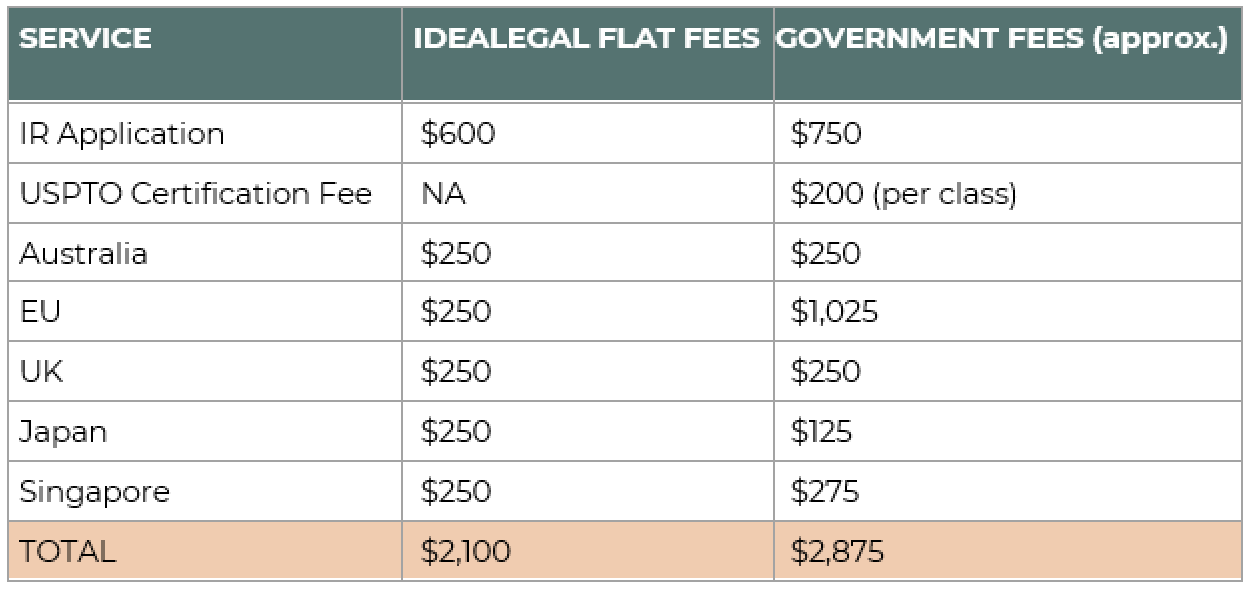
+ FAQ #24a. When is my mark “descriptive” and will it prevent me from obtaining Brand Registry?
For good reason, the trademark office does not allow any one person to own exclusive rights to words that are "merely descriptive" of their goods or services. A word is “merely descriptive” when it describes a quality, characteristic, function, feature, purpose, or use of the goods. A word is “generic” when it literally defines the products you are selling. “Generic” and “Descriptive” marks are the least protectible marks on the so-called “Spectrum of Distinctiveness.” Types of descriptive marks include:
 Whether having generic or descriptive wording prevents Brand Registry depends on whether part of your mark is descriptive (See FAQ #24a) or your entire mark is descriptive (See FAQ #24b).
Whether having generic or descriptive wording prevents Brand Registry depends on whether part of your mark is descriptive (See FAQ #24a) or your entire mark is descriptive (See FAQ #24b).
+FAQ #24b. Partly descriptive marks - What is a “disclaimer”?
When part of your mark (but not all) is descriptive, you will likely need to “disclaim” the descriptive or generic words from your application. A disclaimer is a statement you include in your application to indicate that you do not claim exclusive rights to an unregistrable portion of your mark. It says, “No claim is made to the exclusive right to use [WORD] apart from the mark as shown.” A disclaimer does not physically remove the words from your mark or affect the appearance of your mark or the way you use it. It is merely a recognition that the disclaimed words need to be freely available for other businesses to use in marketing similarly described goods or services. Here is more information about disclaimers: https://www.uspto.gov/trademark/laws-regulations/how-satisfy-disclaimer-requirement. For obviously descriptive words, we recommend you make the disclaimer in the application. For less obvious descriptive words, we can wait to see if the trademark office requires the disclaimer and make it then.
For instance, for the mark GRUMPY BUFFALO SHOES covering footwear, you will need to disclaim SHOES because other sellers have a right to use that word to describe their products, but you can freely enforce the more distinctive GRUMPY BUFFALO portion of the mark.
+FAQ #24c. Entirely descriptive marks – How can I keep Brand Registry?
When the trademark office determines that an entire mark is “merely descriptive,” the mark can still receive a trademark registration, but the application must be amended to the “Supplemental Register” instead of the “Principal Register” until the mark becomes distinctive. A mark on the Supplemental Register receives many of the same benefits as a mark on the Principal Register. An applicant can thus proceed with registration of a descriptive mark as-is, with the understanding that it will likely be placed on the Supplemental Register.
Importantly, though: Amazon does not allow marks on the Supplemental Register to enroll in Brand Registry. As such, if Amazon Brand Registry is important to your business, then proceeding with a descriptive mark may not be you best option. An Amazon seller with a descriptive mark has the following options:
Option A: Apply for the word mark as-is. There is always a chance the trademark office will not consider the mark to be descriptive, so you can take your chances. Under this option, you can join Brand Registry once the application is filed. The trademark office will likely then issue a “merely descriptive” refusal about 10 months from application dates, and you will have another three months before the mark is forced onto the Supplemental Register. If the mark is forced to the Supplemental Register, Amazon can remove your brand from Brand Registry. This means you have just over a year before the mark goes on the Supplemental Register. During that time, you can enjoy Brand Registry in the mark and put into place one of the options discussed below.
Option B: Proceed with a different mark. You can choose a different trademark that includes at least one distinctive "strong" word. A “strong” word is unique in the context of the products you are selling. The possibilities are infinite! Some of the strongest words are completely made-up and, though it may seem counterintuitive, the more “random” your wording is, considering your products, the stronger it is and the more distinctive your brand.
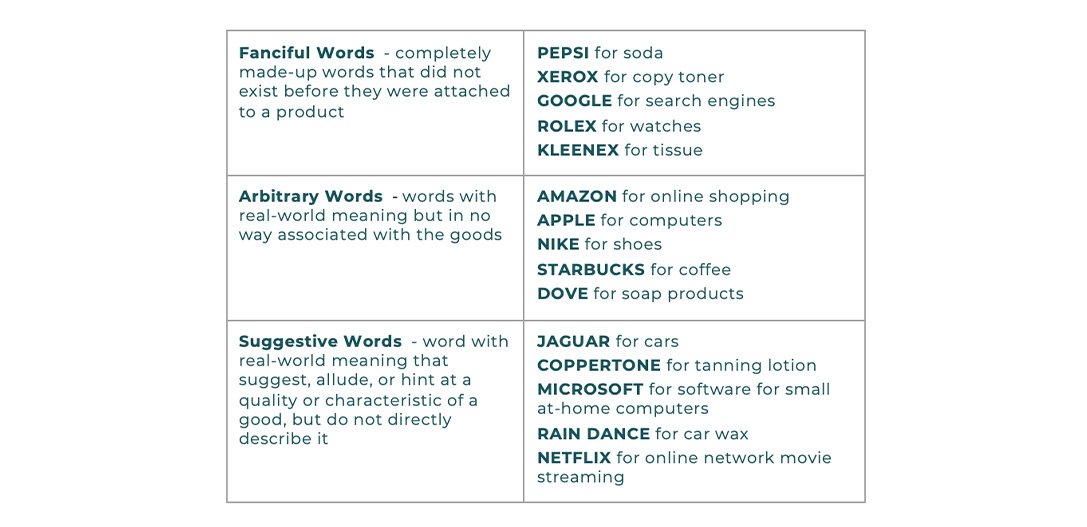
- Option C: Proceed with a Design Mark. If you have a “design mark” (sometimes called a logo), as discussed in our FAQ #3, that includes material design elements in addition to the words, then you may get the mark onto the Principal Register for the design elements alone. You would “disclaim” the wording, as discussed above in FAQ #24b. A design mark application qualifies for early entry to Brand Registry.
This approach only works if your mark includes material design elements (think pictures or graphics). Mere stylized lettering, simple background coloring, and outlining are not material design elements. As an example
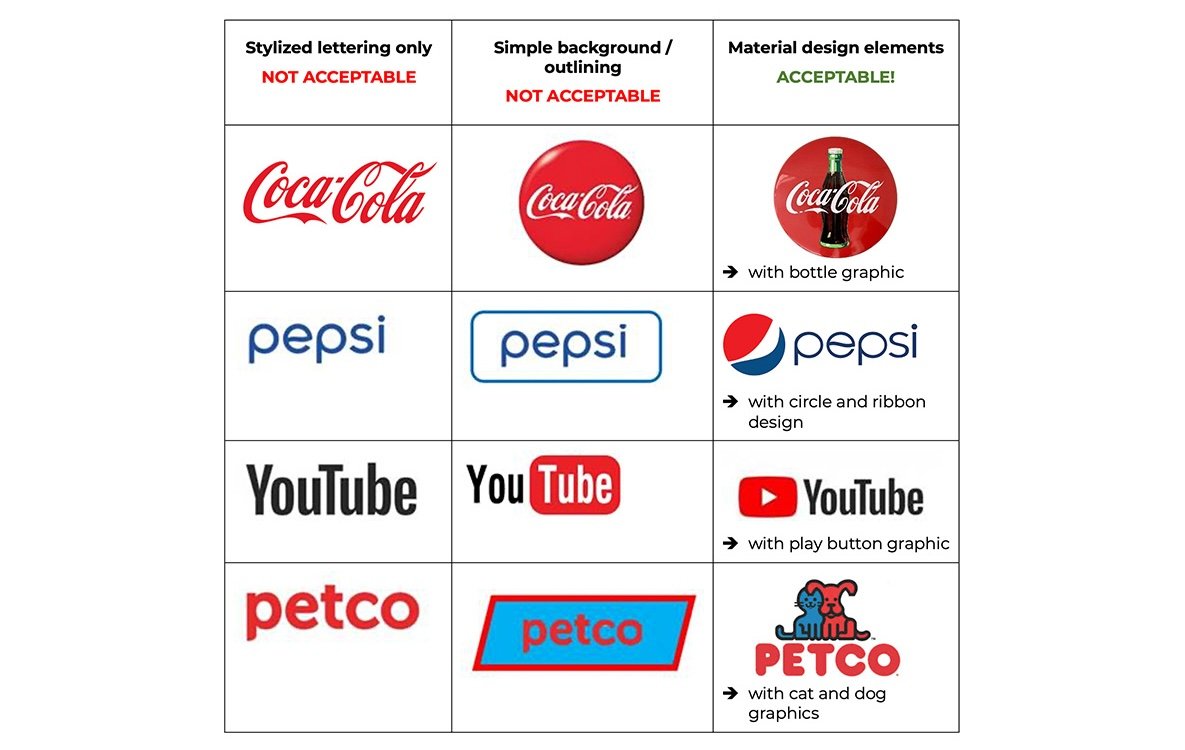
+ FAQ #25. After IdeaLegal files my application, can I switch out lawyers or represent myself and stay in Brand Registry?
We understand that you may have existing relationships with other trademark lawyers or, for cost reasons, you may like the option of handling your own trademark application once you have obtained Brand Registry, but unfortunately, you will lose Brand Registry if you remove our firm during the prosecution of your application. Amazon has chosen specific firms for the IP Accelerator (IPA) program because it has confidence in their work. Amazon requires that, to keep Brand Registry, you stick with one of those firms through the registration process. Amazon instructs us as follows:
If a seller terminates the IPA firm engagement prior to the application issuing to registration, the application will no longer qualify for the IP Accelerator early access to Brand Registry benefits and automated brand protections. This applies whether the sellers represent themselves, or engage a non-participating law firm.
Please contact us when you become aware of a disengagement and provide the Order ID and application serial number.
We are thus obligated to report to Amazon that you have removed us as counsel for your application.
+ FAQ #26. What is “Likelihood of Confusion”?
One of the main functions of a trademark is to prevent consumer confusion as to the source of the goods offered under the mark. For instance, when you see mark AMAZON (word mark) or  (design mark) on a speaker, you, as a consumer, should have confidence in knowing that the speaker comes from Amazon (i.e. Amazon is the source of the speaker). If a competitor company offers speakers under a mark that is similar to Amazon’s marks, then you, as a consumer, might confusingly purchase a speaker from the competitor under the incorrect assumption that is comes from Amazon. In such a case, the competitor’s use of a similar mark to sell related goods created confusion as to the source of the goods. This confusion is called Likelihood of Confusion.
(design mark) on a speaker, you, as a consumer, should have confidence in knowing that the speaker comes from Amazon (i.e. Amazon is the source of the speaker). If a competitor company offers speakers under a mark that is similar to Amazon’s marks, then you, as a consumer, might confusingly purchase a speaker from the competitor under the incorrect assumption that is comes from Amazon. In such a case, the competitor’s use of a similar mark to sell related goods created confusion as to the source of the goods. This confusion is called Likelihood of Confusion.
There are several factors used to determine whether two competing marks may cause Likelihood of Confusion, but the two we are most interested in in are the similarity of the marks and the relatedness of the goods sold under the marks.
Similarity of the marks. Marks may be “confusingly similar” if they (i) sound alike when spoken; (ii) are visually similar; (iii) have the same meaning (when translated); or (iv) create the same general commercial impression. For Example, if you sell pet toys under the mark CRAZY CHICKEN, then the following marks are “similar”:
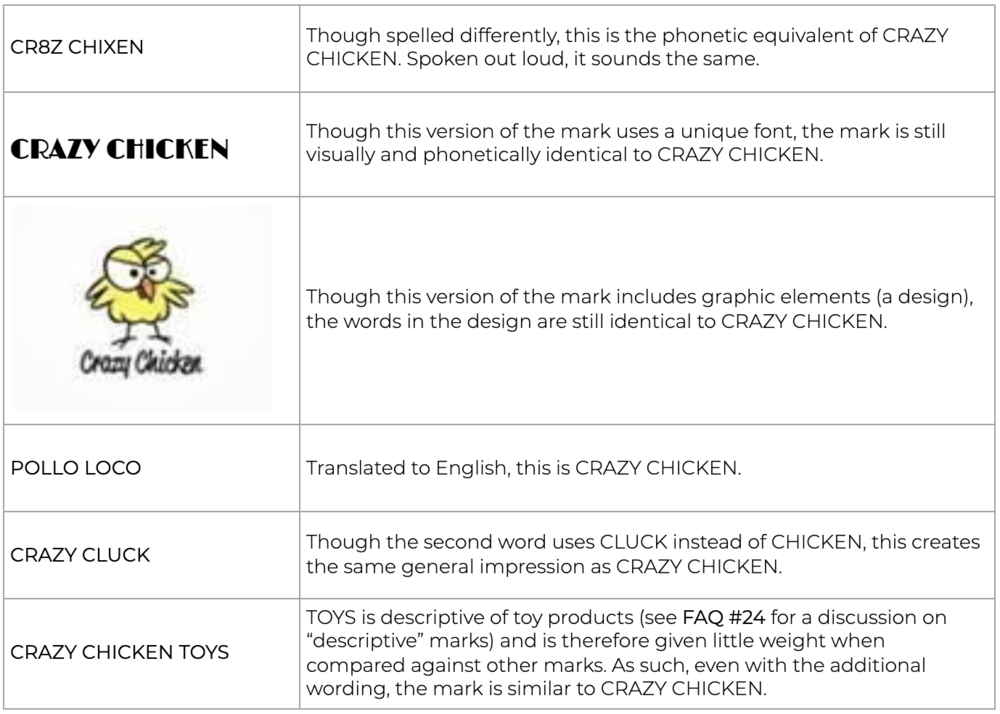
Similarity of the goods. If two marks are similar (as discussed above), and the goods sold under the respective marks are “related,” then there is Likelihood of Confusion. The goods do not need to be identical or even competitive to find Likelihood of Confusion. It is enough that the goods are related in some manner or that the conditions surrounding their marketing are such that they are likely to be encountered by the same consumer in a way that might cause confusion. The more similar or related the goods, the less similar the marks can be to find Likelihood of Confusion. Conversely, if the goods are not related or marketed in such a way that they would be encountered by the same consumer in a way that might cause confusion, then the marks could be identical and not create Likelihood of Confusion. That is why DELTA exists as a trademark for airline services and for high end faucets – though the marks are identical, the goods and services offered under the marks are not related.
+FAQ #27. How can I learn the status of my application?
A U.S. trademark application can take anywhere from one year (best case scenario) to several years (worst case scenario) to register. So, while you are hopefully enjoying significant sales through Amazon’s Brand Registry program, a good amount of patience will be required while your application makes its way through the review process at the USPTO.
As discussed at our FAQ #11, your flat fee covers certain notices from our office as your trademark application processes (those notices are indicated in blue below). As you can see, you can expect to receive your first notice from our office approximately one year after we file your application. We monitor thousands of trademark applications so, unfortunately, we cannot provide each of our clients with frequent updates or notices beyond those covered by the flat fee. If you would like more frequent “check-ins,” please let us know and we can set you up with monthly reporting billed at our hourly rate of $400. Otherwise, if you have not yet received one of the below notices from us, it’s because the event has not yet occurred, so please be patient.
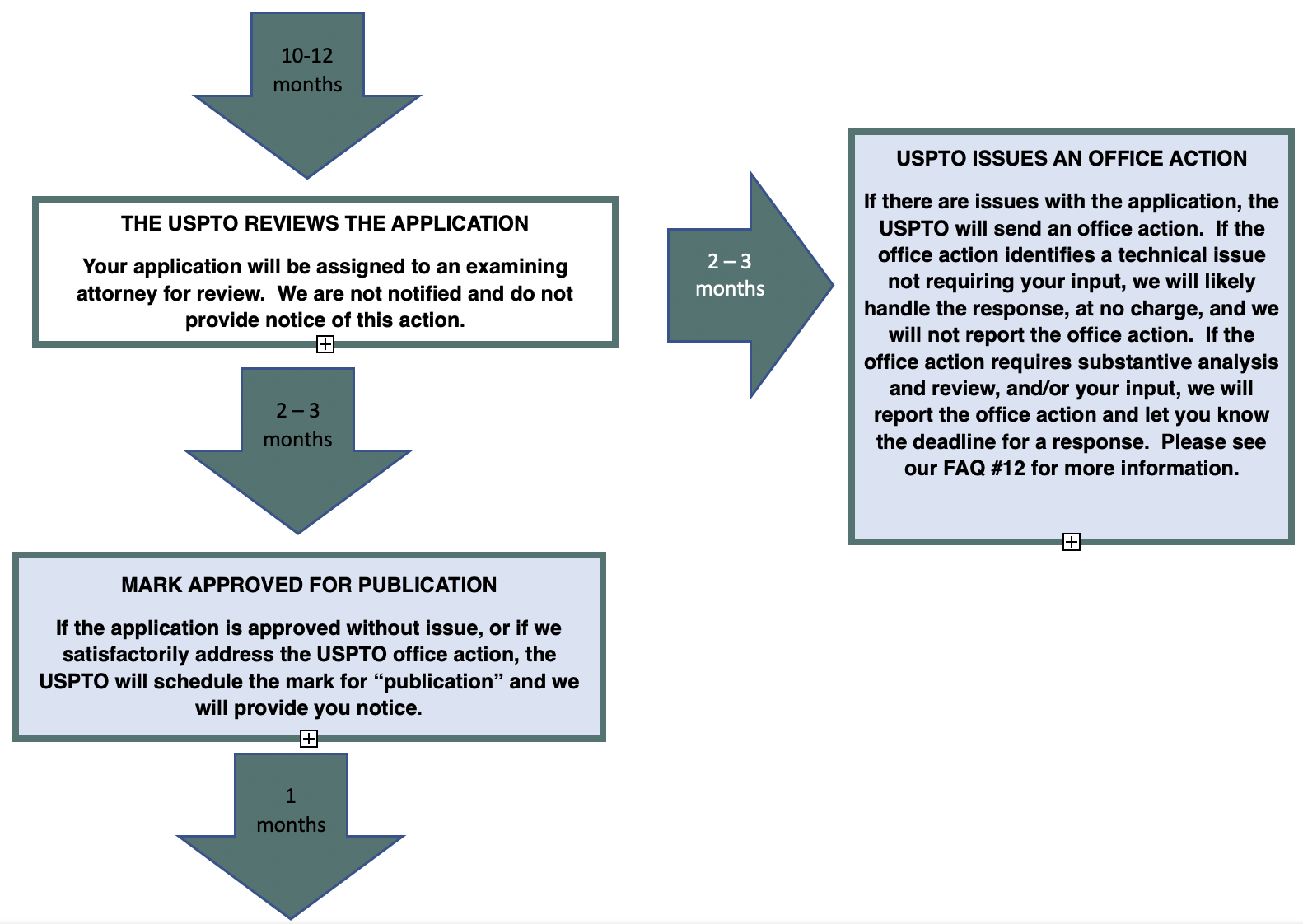
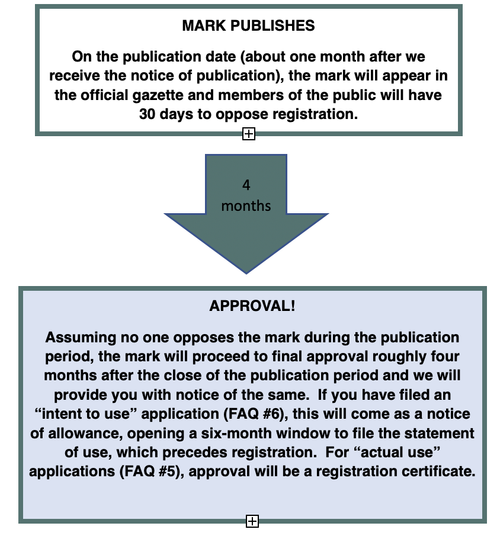
+ FAQ #28. I don’t know what products I will sell under my mark yet; can I still apply for a trademark?
The short answer is no.
Trademark rights in the United States extend only as far as the specific goods you are selling (or intend to sell) with the mark. For instance, Apple owns trademark rights in phones and computers, but does not have trademark rights in tires or airplanes because Apple does not sell tires or airplanes.
You cannot obtain "general" trademark rights in a mark not tied to specific products. As discussed in FAQ #29, we are not able to file a trademark application that is open-ended as to the goods or services covered. This is because the trademark office examines your application for a likelihood of confusion (FAQ #26) with prior marks based on the set specific goods in the application. Instead, you must identify specific products in your application (see FAQ # 30 for information about properly classifying your products). You need to have at least one specific product in mind before we start the application process.
+ FAQ #29. Can my application cover an entire class or category of good?
The short answer is no.
Trademark rights in the United States extend only as far as the specific goods you are selling (or intend to sell) with the mark. For instance, Apple owns trademark rights in phones and computers, but does not have trademark rights in tires or airplanes because Apple does not sell tires or airplanes.
You do not obtain trademark rights to an entire category of goods by virtue of the fact you sell one or some products within the category. For instance, if you use your brand to sell hair brushes, we would apply to register your mark for hair brushes (a specific product) and not “health and beauty” (a category) because “health and beauty” could cover thousands of different products, spanning several International Classes, that you do not sell (i.e. cosmetics in Class 3, supplements in Class 5, massagers in Class 10, or hair wraps in Class 25). Please see FAQ #30 for information about properly classifying your specific products.
Similarly, you cannot obtain trademark rights to an entire Class by virtue of the fact you sell one product within the same Class. For example, if your brand sells hair brushes (Class 21), you do not then obtain trademark rights to all Class 21 products which include things like spatulas, baskets, vases, and coasters.
Note, however, that if your competitor is using a similar mark to sell “related” goods, you may be able to enforce your trademark registration to prevent the sale of those goods even if they are not specifically described in your registration. See FAQ #26 (“Similarity of the goods”) for more information about related goods and likelihood of confusion
+ FAQ #30. How do I determine which products to include in my trademark application?
Many times, figuring out which products to include in your application (or not) is the hardest part of the trademark application process, but we can determine the best way forward using a two-step analysis. First, working together, we will determine the proper classification for your products. Second, you will then weigh application costs vs. benefits, given your personal business needs, to determine which products to include in the application. Each step is discussed below.
Step One – Determining Product Classification
The USPTO follows the “Nice Classification System” that classifies goods and services among 45 “International Classes.” When we talk about a “Class” we are referring to one of the 45 International Classes under the Nice Classification System.
In our questionnaire, we ask you to specifically identify the products you are selling (or intend to sell) under you brand. This is an important step of the application process because it allows us to properly classify your products. We ask that you specifically identify your products because trademark rights in the United States extend only as far as the specific goods you are selling (or intend to sell) with the mark. For instance, Apple owns trademark rights in phones and computers, but does not have trademark rights in tires or airplanes because Apple does not sell tires or airplanes.
By using the UPSTO identification manual (http://idm-tmng.uspto.gov/id-master-list-public.html) , as well as our professional experience and judgment, and based on your questionnaire responses, we will advise on the appropriate Classes for your specific products, which then determines the cost of your application (Please see our FAQ #10 for fees). Let’s use some examples:
Amir: In response to the questionnaire, Amir identifies the products sold under his brand as “health and beauty products.” “Health and beauty products” is not an acceptable identification because it could cover thousands of different products spanning several Classes (i.e. cosmetics in Class 3, supplements in class 5, massagers in Class 10, or hair wraps in class 25). The USPTO would issue an office action response requiring Amir to clarify his goods description, which would cause delay and additional expense. In this case, we would direct Amir to this FAQ and ask him to follow up with specific product identifications before we can provide guidance on classifications or fees.
Maria: In response to the questionnaire, Maria identifies the products sold under her brand as: bath toys, shampoo, washcloths, towels, bathrobes, bar soap, pet brushes, pet shampoo, hair brushes. Using the UPSTO identification manual (http://idm-tmng.uspto.gov/id-master-list-public.html) , as well as our professional experience and judgment, we are able to advise Maria that her products belong in the following Classes:
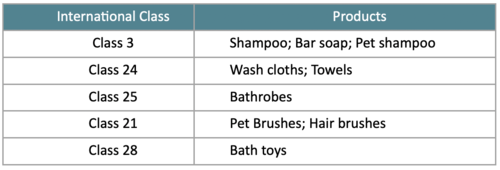
Now that we have properly classified Maria’s products, Maria must determine which products she would like to include in the application in Step 2.
Step 2 – Determining Which Products to Include in the Application
The number of Classes claimed in the application determines the cost of the application: the more Classes, the higher the cost (see FAQ #10 for pricing information by Class). But the products identified in your application also determine the scope of your registered trademark rights: the more registered products, the broader your rights. So you must weigh cost against stronger trademark rights, as shown below.

Your application may include as many (or few) products as you wish. Importantly, for Amazon, you only need a trademark application covering at least one product to be invited to Brand Registry. As far as Amazon in concerned, once you are enrolled in Brand Registry, you can sell whatever products you want through your Brand Registry account without having registered trademark rights in the "other" products. Given the cost, many Amazon sellers choose to apply for only one of some of their core products (the most profitable products, and the ones most likely to be copied). But there are several benefits to having registered, enforceable trademark rights, in all or most of your products including:
Amazon will consider whether you have registered trademark rights in a specific product before agreeing to remove the listings of potentially infringing sellers. For instance, if your brand is used to sell shampoo (Class 3), bathrobes (Class 25), and towels (Class 24), and you decide to include only the shampoo product in your application, you may enroll in Brand Registry and sell all products through your Brand Registry account. However, if someone later sells towels under a mark that is the same or highly similar to your mark, and you ask Amazon to stop these sales, Amazon may choose not to enforce your brand against the other seller since you do not have registered trademark rights for towels.
Having registered trademark rights in one product should prevent another seller from obtaining a trademark registration for a similar mark for the same or “related” products as this would cause “likelihood of confusion” (see FAQ #26 for a discussion on likelihood of confusion). What is or is not a “related” product is a somewhat subjective judgement call for an examining attorney to make. For instance, if your brand is used to sell shampoo (Class 3), bathrobes (Class 25), and towels (Class 24), and you decide to include only the shampoo product in your application, you will have registered trademark rights in shampoo only. If someone later applies for the same mark for bathrobes, and the trademark office determines bathrobes are not “related” to shampoo, the trademark office will allow registration of the other mark for bathrobes. If your application had originally included bathrobes, the after-filed application would have been refused registration for the same mark selling bathrobes.
With the above in mind, you must make a business decision that is personal to you and your business, weighing costs and benefits, about how many classes to include in your application.
+ FAQ #31. Once my trademark registers, how do I renew the registration?
A window for renewing your registration with the USPTO opens between the 5th and 6th anniversary of your trademark registration date. To renew the registration, we will submit evidence (a “specimen,” FAQ #8) to the USPTO showing that you are still using the mark for the goods identified in the registration.
Subsequent renewal windows open every ten years.
When these renewal windows open, we will send you an email with your renewal options and costs. There is no charge for keeping track of and notifying you of the renewal deadlines. Please make sure to let us know if your email contact information changes, so we can update our records and let you know about these deadlines.
At this time, the fees for maintenance filing services are as follows:

Finished With the FAQ? Time For the Next Step!
Whether you’re ready to work with us or you just want more information, the first step is to get in touch with us. Tap the button below and tell us about yourself.
We’ll follow up within one business day to start you on the path to Brand Registry.




